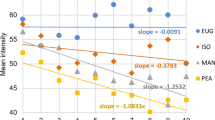Abstract
The aim of the present study was to investigate whether pupillary responses to odorous stimuli reflect their intensity or hedonic tone. A total of 21 healthy subjects participated in the study. Using a computer-controlled olfactometer, subjects received intranasal stimuli including odors of rose (PEA; 2 concentrations), lemon and rotten eggs, plus the trigeminal irritant CO2 (also at two concentrations). Changes in the pupil diameter were obtained ipsilaterally to the side of stimulus presentation. Both trigeminal and olfactory stimulation produced an increase in pupillary diameter. Latencies for pupillary reaction were fastest for the higher concentration of CO2 and slowest after the presentation of PEA at the low concentration. Response amplitudes were largest in response to stimulation with CO2 at the high concentration, while they were smallest in response to odorous stimulation with PEA. Response latencies decreased with increasing stimulus intensity. No such correlation was found for hedonic ratings and pupillary reactions. Thus, the change in the pupillary diameter indicates differences between stimulus modalities and stimulus strength, but not pleasantness or unpleasantness of the odors.

Similar content being viewed by others
References
Alaoui-Ismaïli O, Vernet-Maury E, Dittmar A, Delhomme G, Chanel J (1997a) Odor hedonics: connection with emotional response estimated by autonomic parameters. Chem Senses 22:237–248
Alaoui-Ismaïli O, Robin O, Rada H, Dittmar A, Vernet-Maury E (1997b) Basic emotions evoked by odorants: comparison between autonomic responses and self-evaluation. Physiol Behav 62:713–720
Badia P, Harsh J, Balkin T, O’Rourke D, Burton S (1985) Behavioral control of respiration in sleep and sleepiness to signal-induced sleep fragmentation. Psychophysiology 22:517–524
Barkat S, Thomas-Danguin T, Bensafi M, Rouby C, Sicard G (2003) Odor and color of cosmetic products: correlations between subjective judgement and autonomous nervous system response. Int J Cosmet Sci 25(6):273–283
Beatty J, Lucero-Wagoner B (2000) The pupillary system. In: Cacioppo JT, Tassinary LG, Berntson GG (eds) Handbook of psychophysiology. University Press, Cambridge, pp 142–162
Bennaroch EE (2001) Pain-autonomic interactions: a selective review. Clin Auton Res 11:343–349
Bensafi M, Rouby C, Farget V, Bertrand B, Vigouroux M, Holley A (2002) Autonomic nervous system responses to odours: the role of pleasantness and arousal. Chem Senses 27(8):703–709
Bradley MM, Miccoli L, Escrig MA, Lang PJ (2008) The pupil as a measure of emotional arousal and autonomic activation. Psychophysiology 45(4):602–607
Braüchli P, Rüegg PB, Etzweiler F, Zeier H (1995) Electrocortical and autonomic alteration by administration of a pleasant and an unpleasant odor. Chem Senses 20:505–515
Burton AR, Birznieks I, Bolton PS, Henderson LA, Macefield VG (2009) Effects of deep and superficial experimentally induced acute pain on muscle sympathetic nerve activity in human subjects. J Physiol 587:183–193
Chapman CR, Oka S, Bradshaw DH, Jacobson RC, Donaldson GW (1999) Phasic pupil dilation response to noxious stimulation in normal volunteers: relationship to brain-evoked potentials and pain report. Psychophysiology 36(1):44–52
Doty RL, Brugger WE, Jurs PC, Orndorff MA, Snyder PJ, Lowry LD (1978) Intranasal trigeminal stimulation from odorous volatiles: psychometric responses from anosmic and normal humans. Physiol Behav 20(2):175–185
Doty RL, Deems DA, Frye RE, Pelberg R, Shapiro A (1988) Olfactory sensitivity, nasal resistance, and autonomic function in patients with multiple chemical sensitivities. Arch Otolaryngol Head Neck Surg 114(12):1422–1427
Grunberger J, Linzmayer L, Grunberger M, Saletu B (1993) Pupillometry in clinical psychophysiological studies. Methodology and proposals for applications in psychiatry. Isr J Psychiatry Relat Sci 29:100–113
Hicks RA, Williams SL, Ferrante F (1979) Pupillary attributions of college students to happy and angry faces. Percept Mot Skills 48:401–402
Hummel T, Kobal G (2001) Olfactory event-related potentials. In: Simon SA, Nicolelis MAL (eds) Methods and frontiers in chemosensory research. CRC Press, Boca Raton, pp 429–464
Hummel T, Konnerth CG, Rosenheim K, Kobal G (2001) Screening of olfactory function with a four-minute odor identification test: reliability, normative data, and investigations in patients with olfactory loss. Ann Otol Rhinol Laryngol 110:976–981
Kiecolt-Glaser JK, Graham JE, Malarkey WB, Porter K, Lemeshow S, Glaser R (2008) Olfactory influences on mood and autonomic, endocrine, and immune function. Psychoneuroendocrinology 33(3):328–339
Kobal G (1985) Pain-related electrical potentials of the human nasal mucosa elicited by chemical stimulation. Pain 22:151–163
Lewis T (1942) Pain. McMillan, London
Nishida H (1971) Significance of pupillometry in otorhinolaryngology. Nippon Jibiinkoka Gakkai Kaiho 74:1631–1652
Oka S, Chapman CR, Jacobson RC (2000) Phasic pupil dilation response to noxious stimulation: effect of conduction distance, sex, and age. J Psychophysiol 14(2):97–105
Pavlov IP (1927) Conditioned reflexes. Oxford University Press, London, p 430
Rubin LS, Graham D, Pasker R, Calhoun W (1985) Autonomic nervous system dysfunction in common migraine. Headache J Head Face Pain 25(1):40–48
Schmidt H, Lötsch J (2007) Pharmacokinetic-pharmacodynamic modeling of the miotic effects of dihydrocodeine in humans. Eur J Clin Pharmacol 63:1045–1054
Sneppe R, Gonay P (1973) Evaluation objective, quantitative et qualitative de l’olfaction. Electrodiagn Ther 10:5–17
Tassorelli C, Micieli G, Osipova V, Rossi F, Nappi G (1995) Pupillary and cardiovascular responses to the cold-pressor test. J Auton Nerv Syst 55(1–2):45–49
Uryvaev YV, Zverev YP (1993) The perception of an odogen is proportional to the activity of the autonomous nervous system in man. Zh Vyssh Nerv Deiat Im I P Pavlova 43(6):1075–1079
Winneke G (1992) Structure and determinants of psychophysiological response to odorant/irritant air pollution. Ann NY Acad Sci 641:261–276
Yang LL, Niemann CU, Larson MD (2003) Mechanism of pupillary reflex dilation in awake volunteers and in organ donors. Anesthesiology 99(6):1281–1286
Author information
Authors and Affiliations
Corresponding author
Rights and permissions
About this article
Cite this article
Schneider, C.B., Ziemssen, T., Schuster, B. et al. Pupillary responses to intranasal trigeminal and olfactory stimulation. J Neural Transm 116, 885–889 (2009). https://doi.org/10.1007/s00702-009-0244-7
Received:
Accepted:
Published:
Issue Date:
DOI: https://doi.org/10.1007/s00702-009-0244-7




